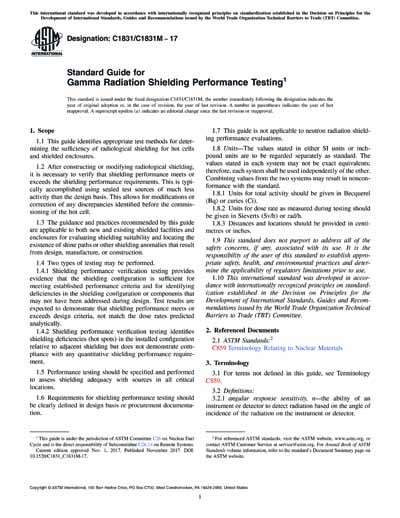Historical
ASTM C1831/C1831M-17
Standard Guide for Gamma Radiation Shielding Performance Testing
1.1 This guide identifies appropriate test methods for determining the sufficiency of radiological shielding for hot cells and shielded enclosures.
1.2 After constructing or modifying radiological shielding, it is necessary to verify that shielding performance meets or exceeds the shielding performance requirements. This is typically accomplished using sealed test sources of much less activity than the design basis. This allows for modifications or correction of any discrepancies identified before the commissioning of the hot cell.
1.3 The guidance and practices recommended by this guide are applicable to both new and existing shielded facilities and enclosures for evaluating shielding suitability and locating the existence of shine paths or other shielding anomalies that result from design, manufacture, or construction.
1.4 Two types of testing may be performed.
1.4.1 Shielding performance verification testing provides evidence that the shielding configuration is sufficient for meeting established performance criteria and for identifying deficiencies in the shielding configuration or components that may not have been addressed during design. Test results are expected to demonstrate that shielding performance meets or exceeds design criteria, not match the dose rates predicted analytically.
1.4.2 Shielding performance verification testing identifies shielding deficiencies (hot spots) in the installed configuration relative to adjacent shielding but does not demonstrate compliance with any quantitative shielding performance requirement.
1.5 Performance testing should be specified and performed to assess shielding adequacy with sources in all critical locations.
1.6 Requirements for shielding performance testing should be clearly defined in design basis or procurement documentation.
1.7 This guide is not applicable to neutron radiation shielding performance evaluations.
1.8 Units—The values stated in either SI units or inch-pound units are to be regarded separately as standard. The values stated in each system may not be exact equivalents; therefore, each system shall be used independently of the other. Combining values from the two systems may result in nonconformance with the standard.
1.8.1 Units for total activity should be given in Becquerel (Bq) or curies (Ci).
1.8.2 Units for dose rate as measured during testing should be given in Sieverts (Sv/h) or rad/h.
1.8.3 Distances and locations should be provided in centimetres or inches.
1.9 This standard does not purport to address all of the safety concerns, if any, associated with its use. It is the responsibility of the user of this standard to establish appropriate safety, health, and environmental practices and determine the applicability of regulatory limitations prior to use.
1.10 This international standard was developed in accordance with internationally recognized principles on standardization established in the Decision on Principles for the Development of International Standards, Guides and Recommendations issued by the World Trade Organization Technical Barriers to Trade (TBT) Committee.
Content Provider
ASTM International [astm]






